Business Management: Unit 5 Management Accounting Report
VerifiedAdded on 2022/12/28
|19
|5462
|44
Report
AI Summary
This report delves into the intricacies of management accounting, exploring its core principles, benefits, and various system types, such as cost accounting, inventory management, and price optimization. It examines different reporting methods, including cost, budget, and performance reports, and illustrates their practical application through a case study of Tesco Plc. The report critically evaluates the integration of management accounting systems and their impact on reporting efficiency, while also comparing absorption and marginal costing methods. Furthermore, it analyzes the advantages and disadvantages of planning tools used for budgetary control, assesses how management accounting aids in addressing financial challenges, and evaluates the role of these tools in achieving sustainable organizational success. The report provides a comprehensive overview of how management accounting principles and tools can be leveraged to enhance financial decision-making and improve overall business performance.
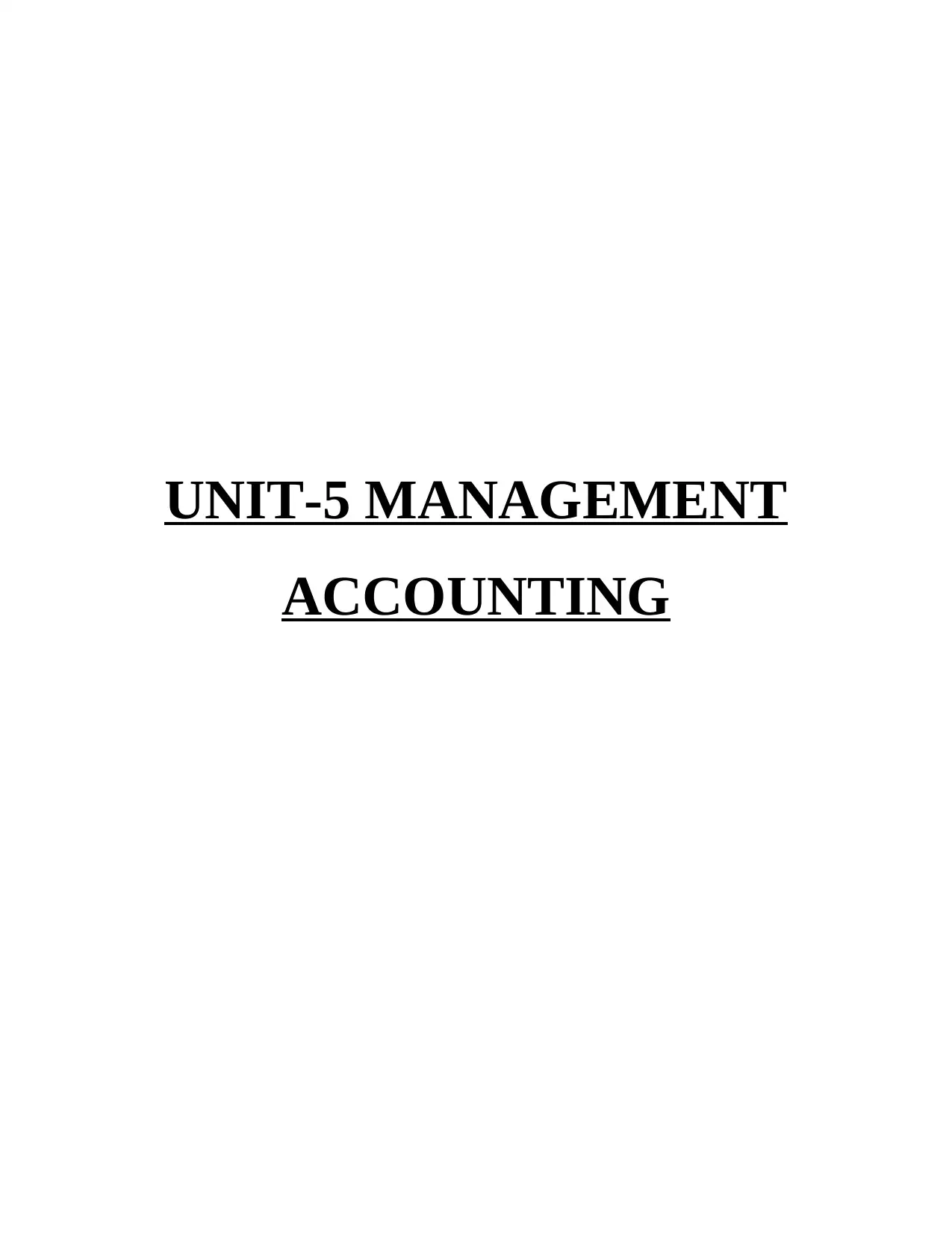
UNIT-5 MANAGEMENT
ACCOUNTING
ACCOUNTING
Paraphrase This Document
Need a fresh take? Get an instant paraphrase of this document with our AI Paraphraser
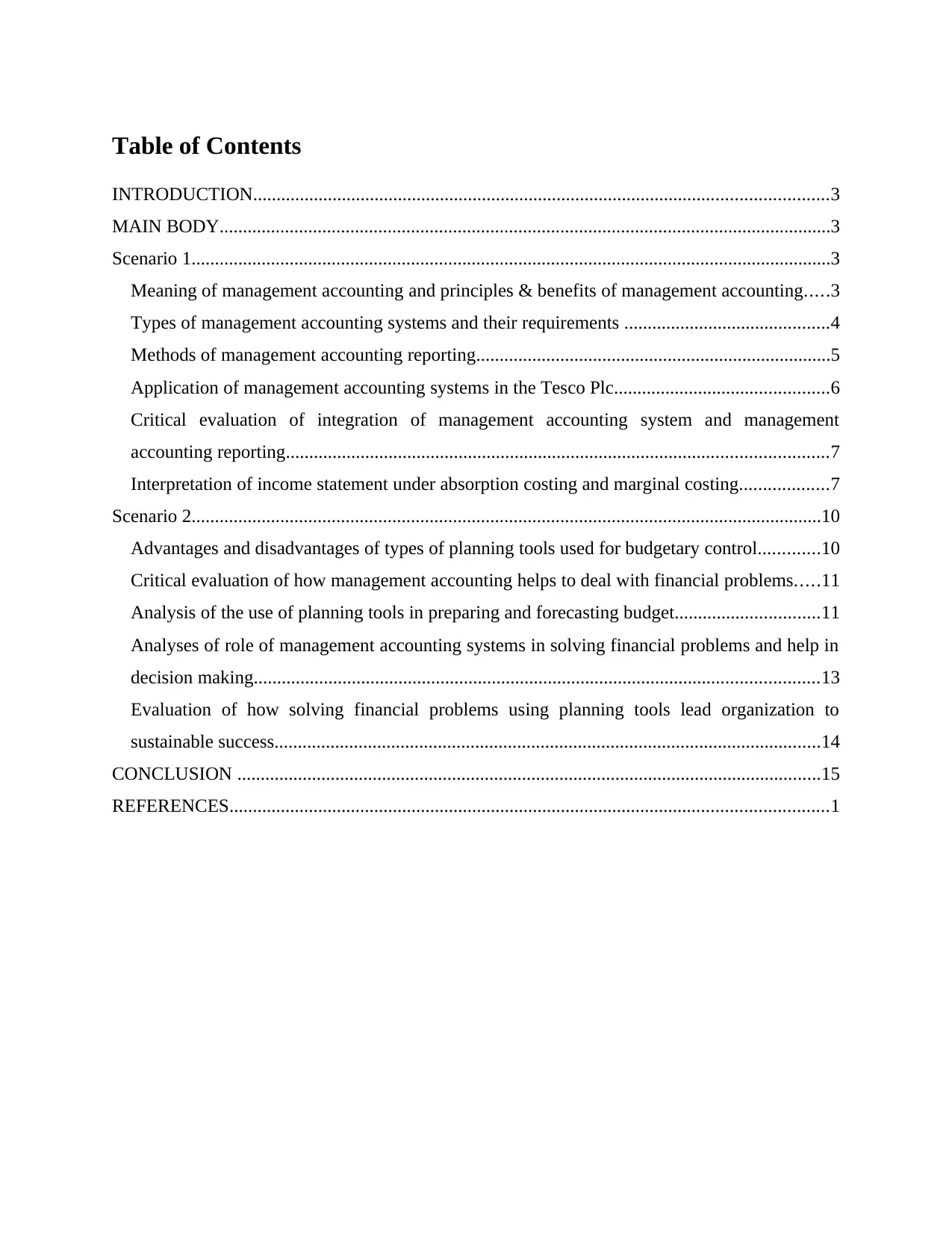
Table of Contents
INTRODUCTION...........................................................................................................................3
MAIN BODY...................................................................................................................................3
Scenario 1.........................................................................................................................................3
Meaning of management accounting and principles & benefits of management accounting.....3
Types of management accounting systems and their requirements ............................................4
Methods of management accounting reporting............................................................................5
Application of management accounting systems in the Tesco Plc..............................................6
Critical evaluation of integration of management accounting system and management
accounting reporting....................................................................................................................7
Interpretation of income statement under absorption costing and marginal costing...................7
Scenario 2.......................................................................................................................................10
Advantages and disadvantages of types of planning tools used for budgetary control.............10
Critical evaluation of how management accounting helps to deal with financial problems.....11
Analysis of the use of planning tools in preparing and forecasting budget...............................11
Analyses of role of management accounting systems in solving financial problems and help in
decision making.........................................................................................................................13
Evaluation of how solving financial problems using planning tools lead organization to
sustainable success.....................................................................................................................14
CONCLUSION .............................................................................................................................15
REFERENCES................................................................................................................................1
INTRODUCTION...........................................................................................................................3
MAIN BODY...................................................................................................................................3
Scenario 1.........................................................................................................................................3
Meaning of management accounting and principles & benefits of management accounting.....3
Types of management accounting systems and their requirements ............................................4
Methods of management accounting reporting............................................................................5
Application of management accounting systems in the Tesco Plc..............................................6
Critical evaluation of integration of management accounting system and management
accounting reporting....................................................................................................................7
Interpretation of income statement under absorption costing and marginal costing...................7
Scenario 2.......................................................................................................................................10
Advantages and disadvantages of types of planning tools used for budgetary control.............10
Critical evaluation of how management accounting helps to deal with financial problems.....11
Analysis of the use of planning tools in preparing and forecasting budget...............................11
Analyses of role of management accounting systems in solving financial problems and help in
decision making.........................................................................................................................13
Evaluation of how solving financial problems using planning tools lead organization to
sustainable success.....................................................................................................................14
CONCLUSION .............................................................................................................................15
REFERENCES................................................................................................................................1
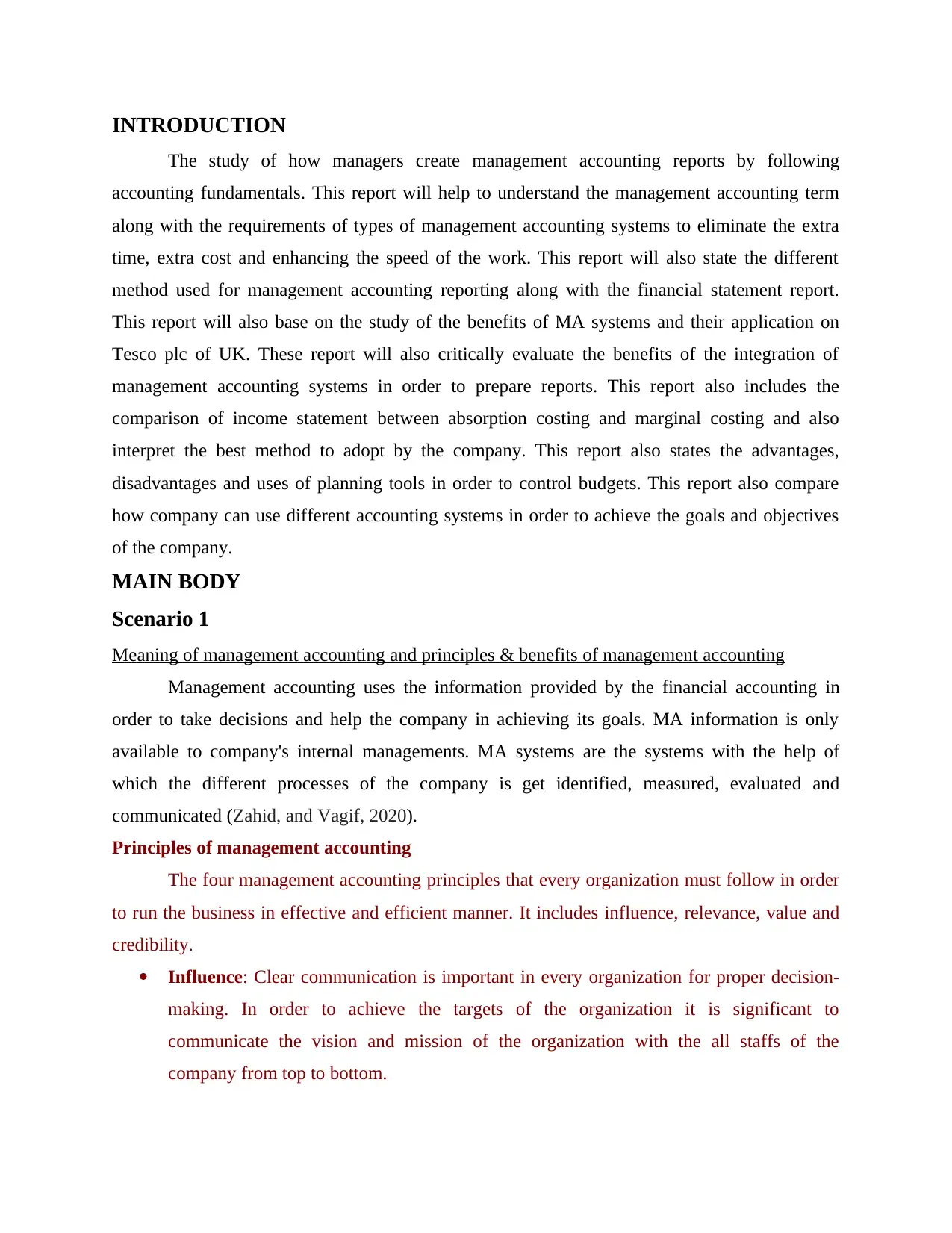
INTRODUCTION
The study of how managers create management accounting reports by following
accounting fundamentals. This report will help to understand the management accounting term
along with the requirements of types of management accounting systems to eliminate the extra
time, extra cost and enhancing the speed of the work. This report will also state the different
method used for management accounting reporting along with the financial statement report.
This report will also base on the study of the benefits of MA systems and their application on
Tesco plc of UK. These report will also critically evaluate the benefits of the integration of
management accounting systems in order to prepare reports. This report also includes the
comparison of income statement between absorption costing and marginal costing and also
interpret the best method to adopt by the company. This report also states the advantages,
disadvantages and uses of planning tools in order to control budgets. This report also compare
how company can use different accounting systems in order to achieve the goals and objectives
of the company.
MAIN BODY
Scenario 1
Meaning of management accounting and principles & benefits of management accounting
Management accounting uses the information provided by the financial accounting in
order to take decisions and help the company in achieving its goals. MA information is only
available to company's internal managements. MA systems are the systems with the help of
which the different processes of the company is get identified, measured, evaluated and
communicated (Zahid, and Vagif, 2020).
Principles of management accounting
The four management accounting principles that every organization must follow in order
to run the business in effective and efficient manner. It includes influence, relevance, value and
credibility.
Influence: Clear communication is important in every organization for proper decision-
making. In order to achieve the targets of the organization it is significant to
communicate the vision and mission of the organization with the all staffs of the
company from top to bottom.
The study of how managers create management accounting reports by following
accounting fundamentals. This report will help to understand the management accounting term
along with the requirements of types of management accounting systems to eliminate the extra
time, extra cost and enhancing the speed of the work. This report will also state the different
method used for management accounting reporting along with the financial statement report.
This report will also base on the study of the benefits of MA systems and their application on
Tesco plc of UK. These report will also critically evaluate the benefits of the integration of
management accounting systems in order to prepare reports. This report also includes the
comparison of income statement between absorption costing and marginal costing and also
interpret the best method to adopt by the company. This report also states the advantages,
disadvantages and uses of planning tools in order to control budgets. This report also compare
how company can use different accounting systems in order to achieve the goals and objectives
of the company.
MAIN BODY
Scenario 1
Meaning of management accounting and principles & benefits of management accounting
Management accounting uses the information provided by the financial accounting in
order to take decisions and help the company in achieving its goals. MA information is only
available to company's internal managements. MA systems are the systems with the help of
which the different processes of the company is get identified, measured, evaluated and
communicated (Zahid, and Vagif, 2020).
Principles of management accounting
The four management accounting principles that every organization must follow in order
to run the business in effective and efficient manner. It includes influence, relevance, value and
credibility.
Influence: Clear communication is important in every organization for proper decision-
making. In order to achieve the targets of the organization it is significant to
communicate the vision and mission of the organization with the all staffs of the
company from top to bottom.
⊘ This is a preview!⊘
Do you want full access?
Subscribe today to unlock all pages.

Trusted by 1+ million students worldwide
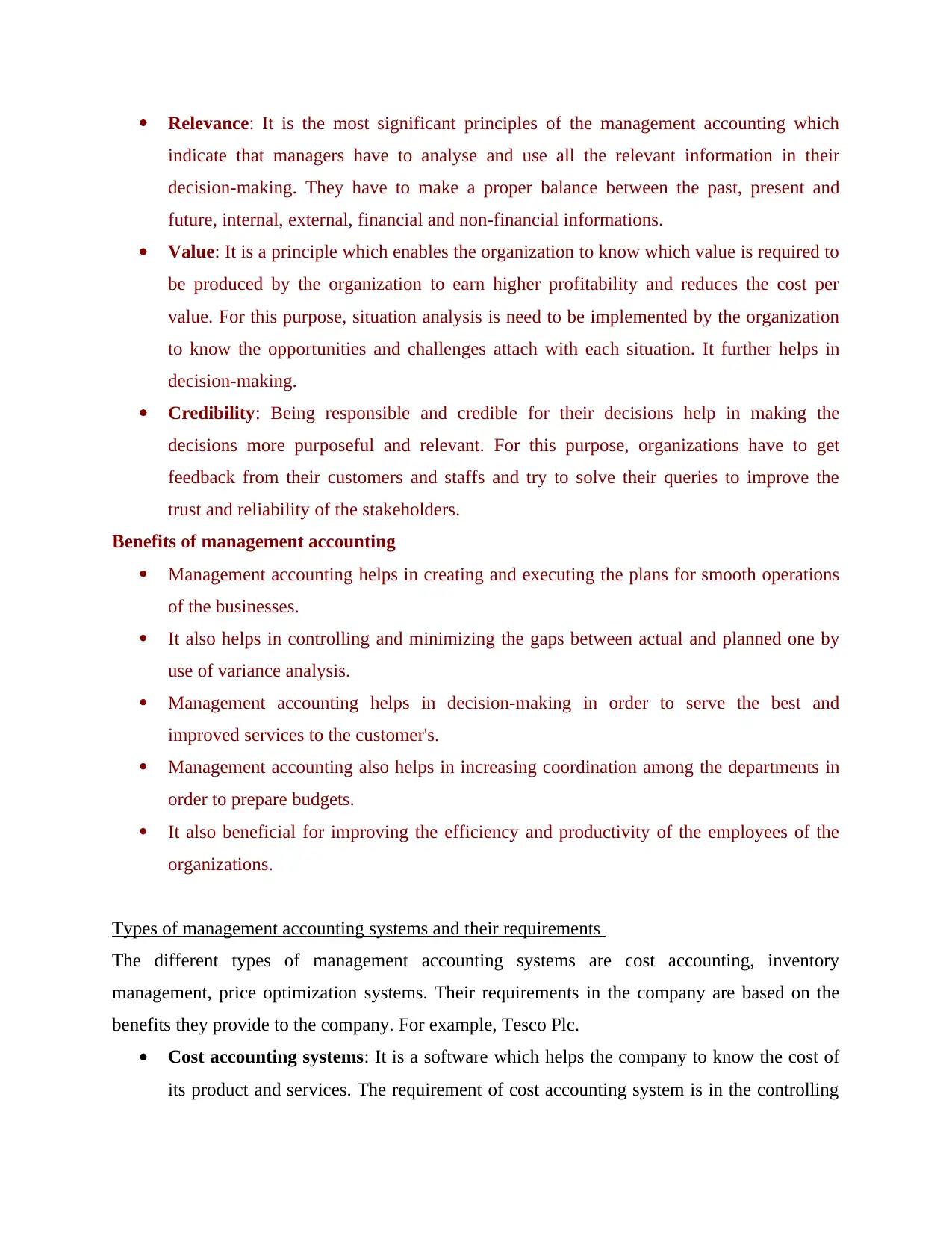
Relevance: It is the most significant principles of the management accounting which
indicate that managers have to analyse and use all the relevant information in their
decision-making. They have to make a proper balance between the past, present and
future, internal, external, financial and non-financial informations.
Value: It is a principle which enables the organization to know which value is required to
be produced by the organization to earn higher profitability and reduces the cost per
value. For this purpose, situation analysis is need to be implemented by the organization
to know the opportunities and challenges attach with each situation. It further helps in
decision-making.
Credibility: Being responsible and credible for their decisions help in making the
decisions more purposeful and relevant. For this purpose, organizations have to get
feedback from their customers and staffs and try to solve their queries to improve the
trust and reliability of the stakeholders.
Benefits of management accounting
Management accounting helps in creating and executing the plans for smooth operations
of the businesses.
It also helps in controlling and minimizing the gaps between actual and planned one by
use of variance analysis.
Management accounting helps in decision-making in order to serve the best and
improved services to the customer's.
Management accounting also helps in increasing coordination among the departments in
order to prepare budgets.
It also beneficial for improving the efficiency and productivity of the employees of the
organizations.
Types of management accounting systems and their requirements
The different types of management accounting systems are cost accounting, inventory
management, price optimization systems. Their requirements in the company are based on the
benefits they provide to the company. For example, Tesco Plc.
Cost accounting systems: It is a software which helps the company to know the cost of
its product and services. The requirement of cost accounting system is in the controlling
indicate that managers have to analyse and use all the relevant information in their
decision-making. They have to make a proper balance between the past, present and
future, internal, external, financial and non-financial informations.
Value: It is a principle which enables the organization to know which value is required to
be produced by the organization to earn higher profitability and reduces the cost per
value. For this purpose, situation analysis is need to be implemented by the organization
to know the opportunities and challenges attach with each situation. It further helps in
decision-making.
Credibility: Being responsible and credible for their decisions help in making the
decisions more purposeful and relevant. For this purpose, organizations have to get
feedback from their customers and staffs and try to solve their queries to improve the
trust and reliability of the stakeholders.
Benefits of management accounting
Management accounting helps in creating and executing the plans for smooth operations
of the businesses.
It also helps in controlling and minimizing the gaps between actual and planned one by
use of variance analysis.
Management accounting helps in decision-making in order to serve the best and
improved services to the customer's.
Management accounting also helps in increasing coordination among the departments in
order to prepare budgets.
It also beneficial for improving the efficiency and productivity of the employees of the
organizations.
Types of management accounting systems and their requirements
The different types of management accounting systems are cost accounting, inventory
management, price optimization systems. Their requirements in the company are based on the
benefits they provide to the company. For example, Tesco Plc.
Cost accounting systems: It is a software which helps the company to know the cost of
its product and services. The requirement of cost accounting system is in the controlling
Paraphrase This Document
Need a fresh take? Get an instant paraphrase of this document with our AI Paraphraser
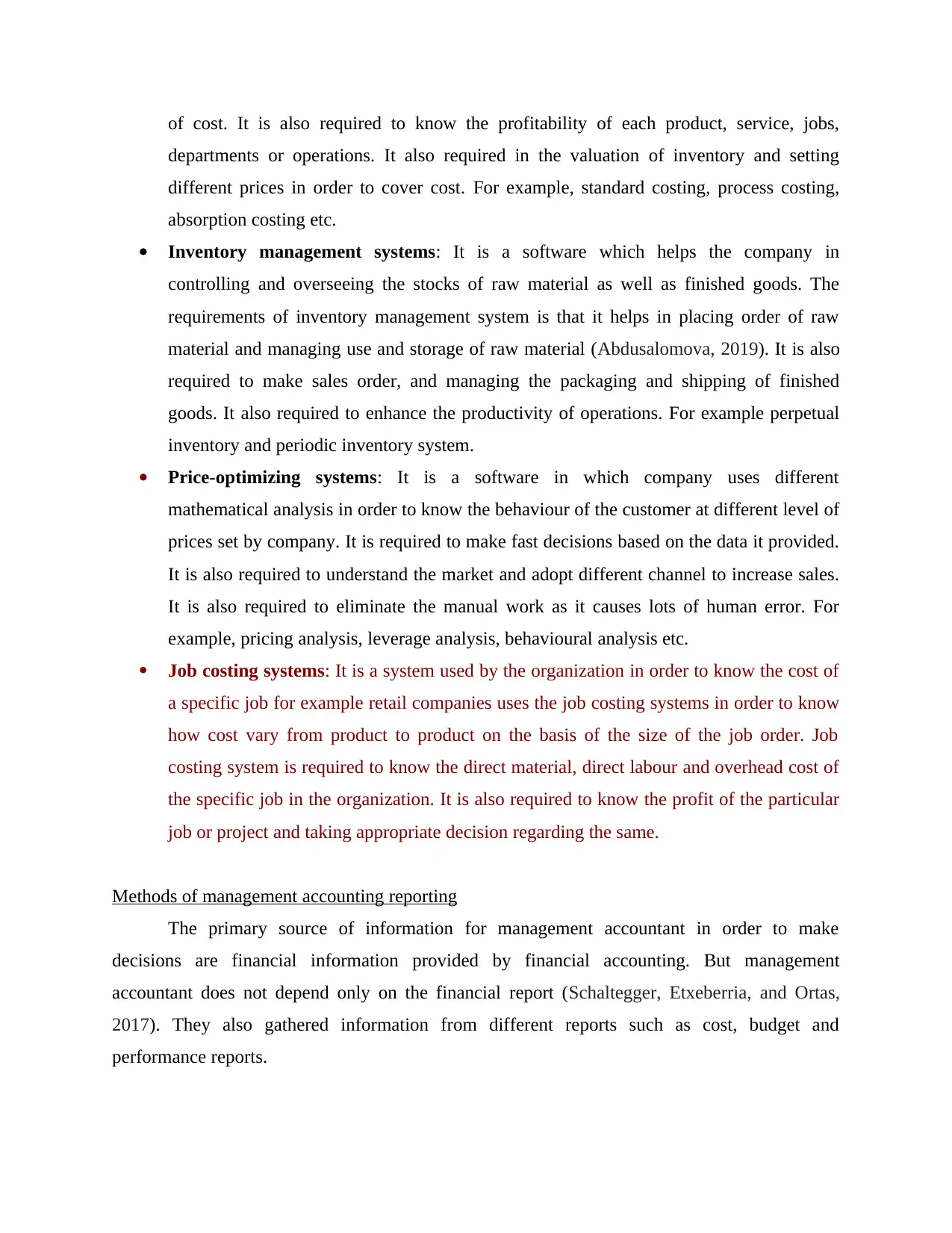
of cost. It is also required to know the profitability of each product, service, jobs,
departments or operations. It also required in the valuation of inventory and setting
different prices in order to cover cost. For example, standard costing, process costing,
absorption costing etc.
Inventory management systems: It is a software which helps the company in
controlling and overseeing the stocks of raw material as well as finished goods. The
requirements of inventory management system is that it helps in placing order of raw
material and managing use and storage of raw material (Abdusalomova, 2019). It is also
required to make sales order, and managing the packaging and shipping of finished
goods. It also required to enhance the productivity of operations. For example perpetual
inventory and periodic inventory system.
Price-optimizing systems: It is a software in which company uses different
mathematical analysis in order to know the behaviour of the customer at different level of
prices set by company. It is required to make fast decisions based on the data it provided.
It is also required to understand the market and adopt different channel to increase sales.
It is also required to eliminate the manual work as it causes lots of human error. For
example, pricing analysis, leverage analysis, behavioural analysis etc.
Job costing systems: It is a system used by the organization in order to know the cost of
a specific job for example retail companies uses the job costing systems in order to know
how cost vary from product to product on the basis of the size of the job order. Job
costing system is required to know the direct material, direct labour and overhead cost of
the specific job in the organization. It is also required to know the profit of the particular
job or project and taking appropriate decision regarding the same.
Methods of management accounting reporting
The primary source of information for management accountant in order to make
decisions are financial information provided by financial accounting. But management
accountant does not depend only on the financial report (Schaltegger, Etxeberria, and Ortas,
2017). They also gathered information from different reports such as cost, budget and
performance reports.
departments or operations. It also required in the valuation of inventory and setting
different prices in order to cover cost. For example, standard costing, process costing,
absorption costing etc.
Inventory management systems: It is a software which helps the company in
controlling and overseeing the stocks of raw material as well as finished goods. The
requirements of inventory management system is that it helps in placing order of raw
material and managing use and storage of raw material (Abdusalomova, 2019). It is also
required to make sales order, and managing the packaging and shipping of finished
goods. It also required to enhance the productivity of operations. For example perpetual
inventory and periodic inventory system.
Price-optimizing systems: It is a software in which company uses different
mathematical analysis in order to know the behaviour of the customer at different level of
prices set by company. It is required to make fast decisions based on the data it provided.
It is also required to understand the market and adopt different channel to increase sales.
It is also required to eliminate the manual work as it causes lots of human error. For
example, pricing analysis, leverage analysis, behavioural analysis etc.
Job costing systems: It is a system used by the organization in order to know the cost of
a specific job for example retail companies uses the job costing systems in order to know
how cost vary from product to product on the basis of the size of the job order. Job
costing system is required to know the direct material, direct labour and overhead cost of
the specific job in the organization. It is also required to know the profit of the particular
job or project and taking appropriate decision regarding the same.
Methods of management accounting reporting
The primary source of information for management accountant in order to make
decisions are financial information provided by financial accounting. But management
accountant does not depend only on the financial report (Schaltegger, Etxeberria, and Ortas,
2017). They also gathered information from different reports such as cost, budget and
performance reports.
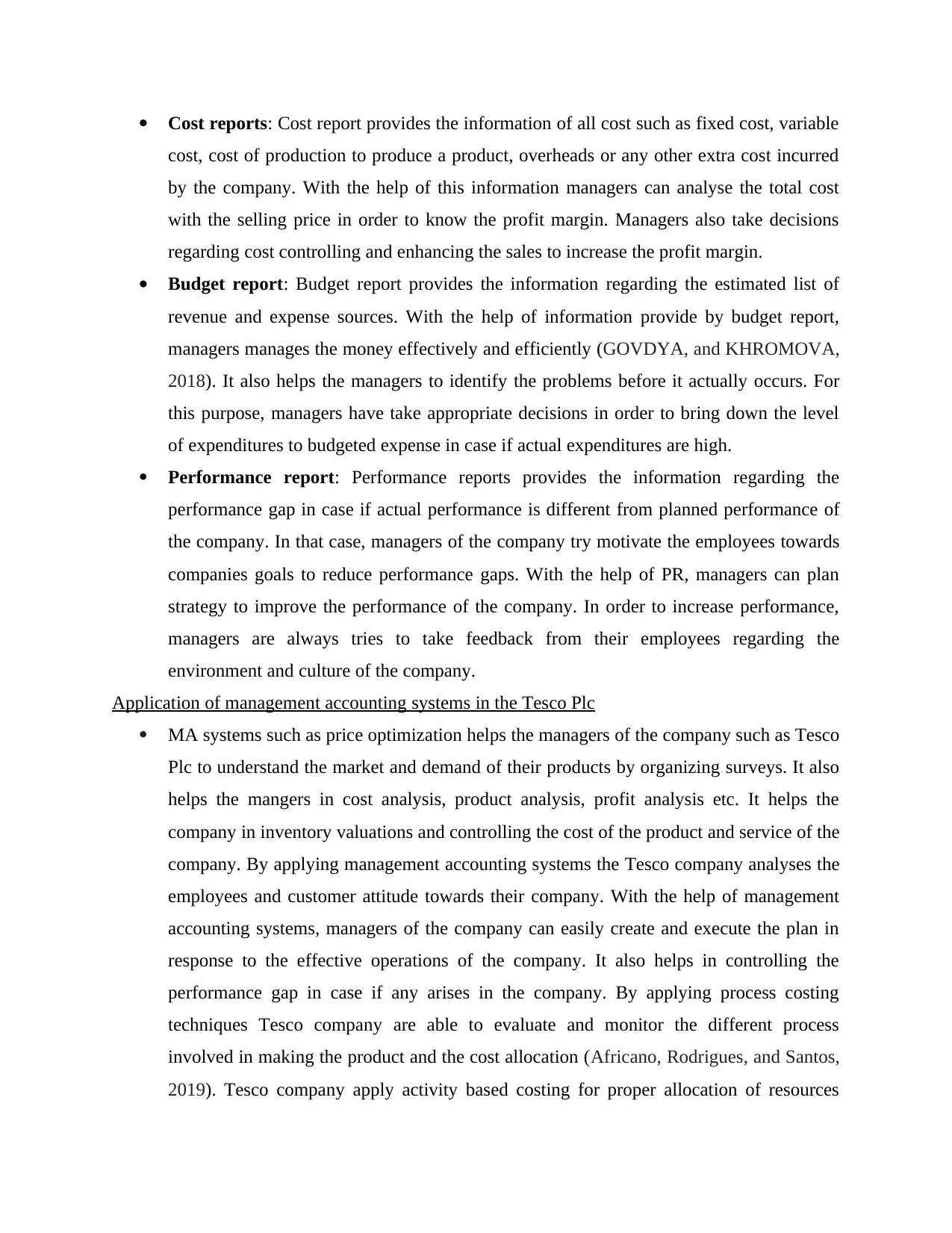
Cost reports: Cost report provides the information of all cost such as fixed cost, variable
cost, cost of production to produce a product, overheads or any other extra cost incurred
by the company. With the help of this information managers can analyse the total cost
with the selling price in order to know the profit margin. Managers also take decisions
regarding cost controlling and enhancing the sales to increase the profit margin.
Budget report: Budget report provides the information regarding the estimated list of
revenue and expense sources. With the help of information provide by budget report,
managers manages the money effectively and efficiently (GOVDYA, and KHROMOVA,
2018). It also helps the managers to identify the problems before it actually occurs. For
this purpose, managers have take appropriate decisions in order to bring down the level
of expenditures to budgeted expense in case if actual expenditures are high.
Performance report: Performance reports provides the information regarding the
performance gap in case if actual performance is different from planned performance of
the company. In that case, managers of the company try motivate the employees towards
companies goals to reduce performance gaps. With the help of PR, managers can plan
strategy to improve the performance of the company. In order to increase performance,
managers are always tries to take feedback from their employees regarding the
environment and culture of the company.
Application of management accounting systems in the Tesco Plc
MA systems such as price optimization helps the managers of the company such as Tesco
Plc to understand the market and demand of their products by organizing surveys. It also
helps the mangers in cost analysis, product analysis, profit analysis etc. It helps the
company in inventory valuations and controlling the cost of the product and service of the
company. By applying management accounting systems the Tesco company analyses the
employees and customer attitude towards their company. With the help of management
accounting systems, managers of the company can easily create and execute the plan in
response to the effective operations of the company. It also helps in controlling the
performance gap in case if any arises in the company. By applying process costing
techniques Tesco company are able to evaluate and monitor the different process
involved in making the product and the cost allocation (Africano, Rodrigues, and Santos,
2019). Tesco company apply activity based costing for proper allocation of resources
cost, cost of production to produce a product, overheads or any other extra cost incurred
by the company. With the help of this information managers can analyse the total cost
with the selling price in order to know the profit margin. Managers also take decisions
regarding cost controlling and enhancing the sales to increase the profit margin.
Budget report: Budget report provides the information regarding the estimated list of
revenue and expense sources. With the help of information provide by budget report,
managers manages the money effectively and efficiently (GOVDYA, and KHROMOVA,
2018). It also helps the managers to identify the problems before it actually occurs. For
this purpose, managers have take appropriate decisions in order to bring down the level
of expenditures to budgeted expense in case if actual expenditures are high.
Performance report: Performance reports provides the information regarding the
performance gap in case if actual performance is different from planned performance of
the company. In that case, managers of the company try motivate the employees towards
companies goals to reduce performance gaps. With the help of PR, managers can plan
strategy to improve the performance of the company. In order to increase performance,
managers are always tries to take feedback from their employees regarding the
environment and culture of the company.
Application of management accounting systems in the Tesco Plc
MA systems such as price optimization helps the managers of the company such as Tesco
Plc to understand the market and demand of their products by organizing surveys. It also
helps the mangers in cost analysis, product analysis, profit analysis etc. It helps the
company in inventory valuations and controlling the cost of the product and service of the
company. By applying management accounting systems the Tesco company analyses the
employees and customer attitude towards their company. With the help of management
accounting systems, managers of the company can easily create and execute the plan in
response to the effective operations of the company. It also helps in controlling the
performance gap in case if any arises in the company. By applying process costing
techniques Tesco company are able to evaluate and monitor the different process
involved in making the product and the cost allocation (Africano, Rodrigues, and Santos,
2019). Tesco company apply activity based costing for proper allocation of resources
⊘ This is a preview!⊘
Do you want full access?
Subscribe today to unlock all pages.

Trusted by 1+ million students worldwide
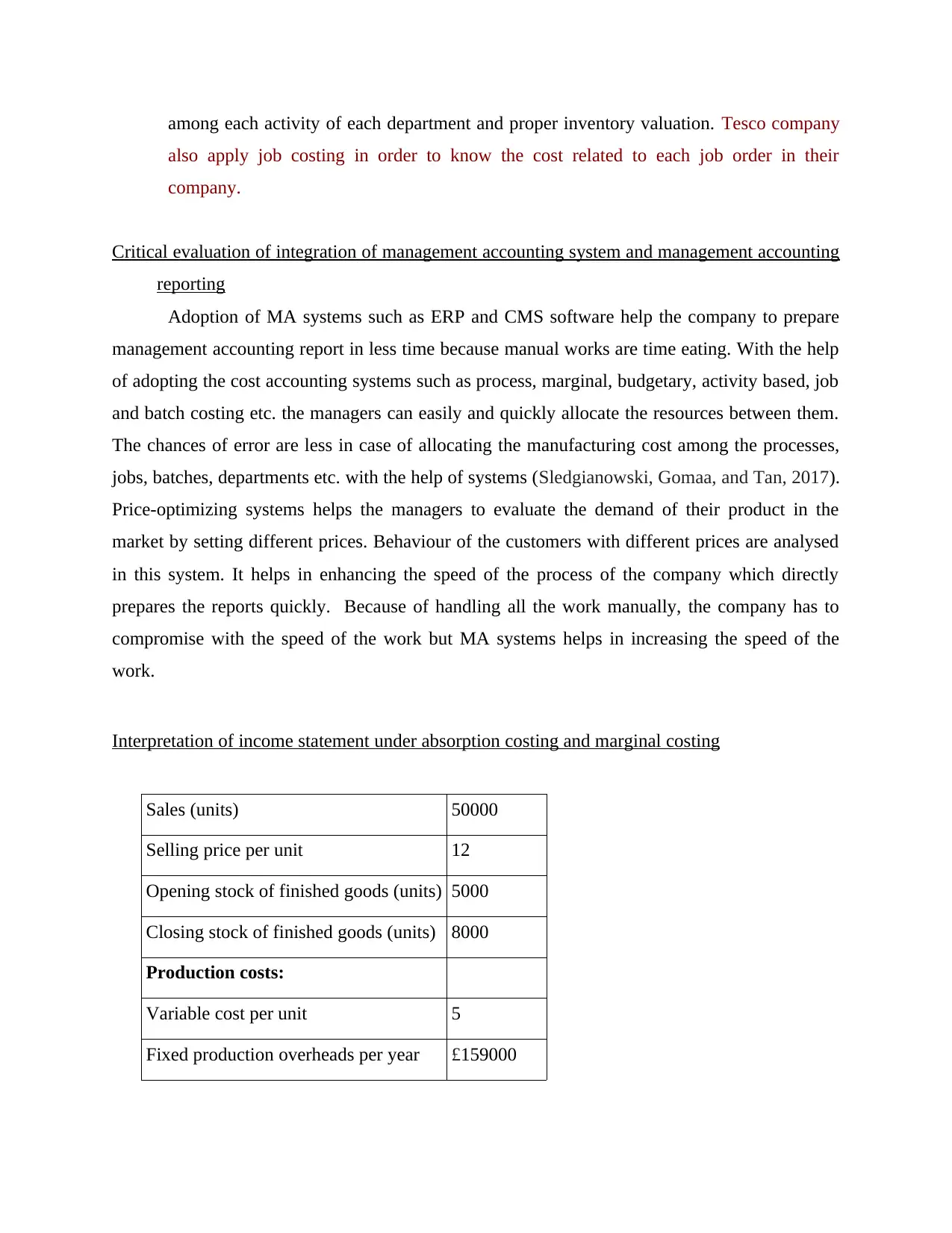
among each activity of each department and proper inventory valuation. Tesco company
also apply job costing in order to know the cost related to each job order in their
company.
Critical evaluation of integration of management accounting system and management accounting
reporting
Adoption of MA systems such as ERP and CMS software help the company to prepare
management accounting report in less time because manual works are time eating. With the help
of adopting the cost accounting systems such as process, marginal, budgetary, activity based, job
and batch costing etc. the managers can easily and quickly allocate the resources between them.
The chances of error are less in case of allocating the manufacturing cost among the processes,
jobs, batches, departments etc. with the help of systems (Sledgianowski, Gomaa, and Tan, 2017).
Price-optimizing systems helps the managers to evaluate the demand of their product in the
market by setting different prices. Behaviour of the customers with different prices are analysed
in this system. It helps in enhancing the speed of the process of the company which directly
prepares the reports quickly. Because of handling all the work manually, the company has to
compromise with the speed of the work but MA systems helps in increasing the speed of the
work.
Interpretation of income statement under absorption costing and marginal costing
Sales (units) 50000
Selling price per unit 12
Opening stock of finished goods (units) 5000
Closing stock of finished goods (units) 8000
Production costs:
Variable cost per unit 5
Fixed production overheads per year £159000
also apply job costing in order to know the cost related to each job order in their
company.
Critical evaluation of integration of management accounting system and management accounting
reporting
Adoption of MA systems such as ERP and CMS software help the company to prepare
management accounting report in less time because manual works are time eating. With the help
of adopting the cost accounting systems such as process, marginal, budgetary, activity based, job
and batch costing etc. the managers can easily and quickly allocate the resources between them.
The chances of error are less in case of allocating the manufacturing cost among the processes,
jobs, batches, departments etc. with the help of systems (Sledgianowski, Gomaa, and Tan, 2017).
Price-optimizing systems helps the managers to evaluate the demand of their product in the
market by setting different prices. Behaviour of the customers with different prices are analysed
in this system. It helps in enhancing the speed of the process of the company which directly
prepares the reports quickly. Because of handling all the work manually, the company has to
compromise with the speed of the work but MA systems helps in increasing the speed of the
work.
Interpretation of income statement under absorption costing and marginal costing
Sales (units) 50000
Selling price per unit 12
Opening stock of finished goods (units) 5000
Closing stock of finished goods (units) 8000
Production costs:
Variable cost per unit 5
Fixed production overheads per year £159000
Paraphrase This Document
Need a fresh take? Get an instant paraphrase of this document with our AI Paraphraser
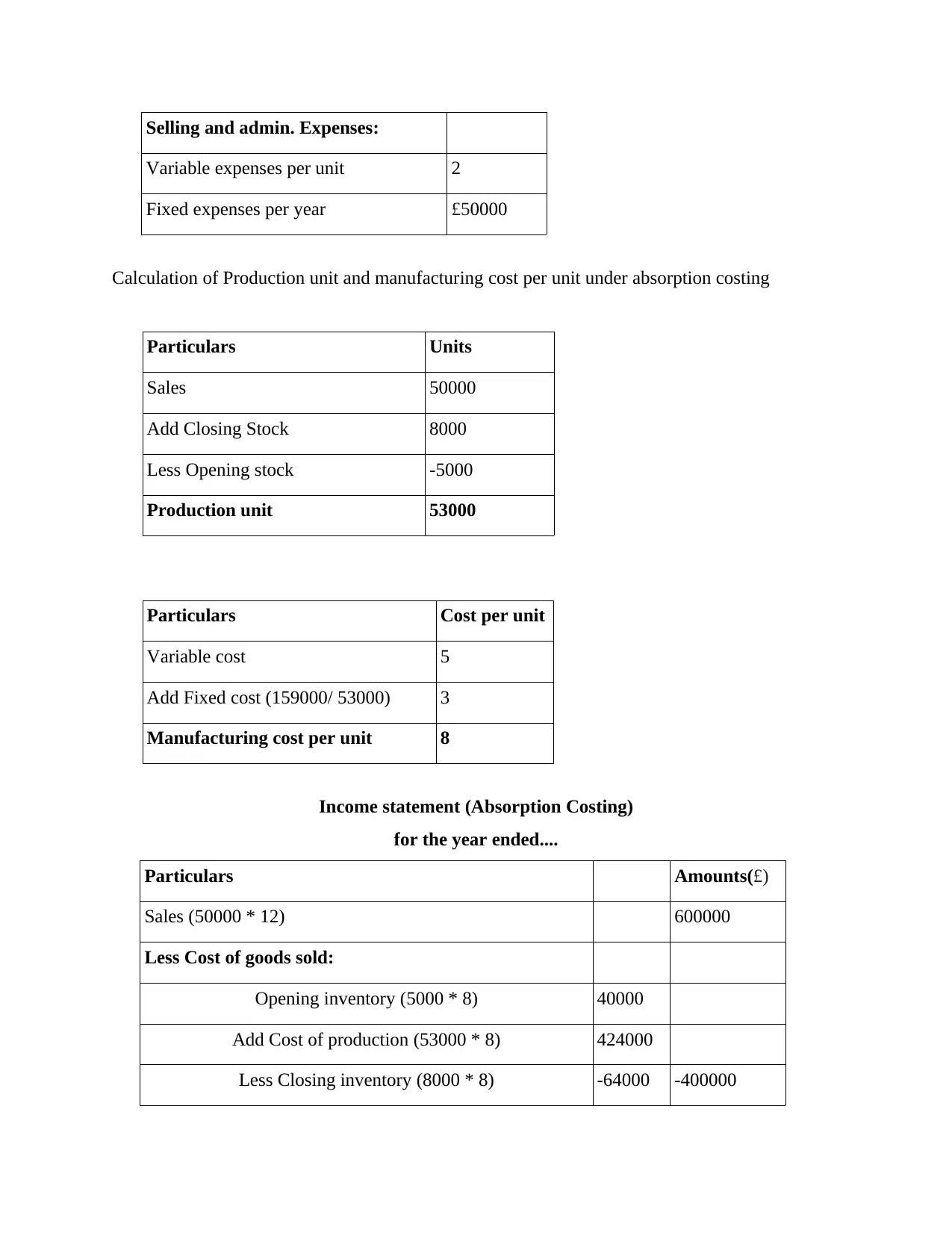
Selling and admin. Expenses:
Variable expenses per unit 2
Fixed expenses per year £50000
Calculation of Production unit and manufacturing cost per unit under absorption costing
Particulars Units
Sales 50000
Add Closing Stock 8000
Less Opening stock -5000
Production unit 53000
Particulars Cost per unit
Variable cost 5
Add Fixed cost (159000/ 53000) 3
Manufacturing cost per unit 8
Income statement (Absorption Costing)
for the year ended....
Particulars Amounts(£)
Sales (50000 * 12) 600000
Less Cost of goods sold:
Opening inventory (5000 * 8) 40000
Add Cost of production (53000 * 8) 424000
Less Closing inventory (8000 * 8) -64000 -400000
Variable expenses per unit 2
Fixed expenses per year £50000
Calculation of Production unit and manufacturing cost per unit under absorption costing
Particulars Units
Sales 50000
Add Closing Stock 8000
Less Opening stock -5000
Production unit 53000
Particulars Cost per unit
Variable cost 5
Add Fixed cost (159000/ 53000) 3
Manufacturing cost per unit 8
Income statement (Absorption Costing)
for the year ended....
Particulars Amounts(£)
Sales (50000 * 12) 600000
Less Cost of goods sold:
Opening inventory (5000 * 8) 40000
Add Cost of production (53000 * 8) 424000
Less Closing inventory (8000 * 8) -64000 -400000
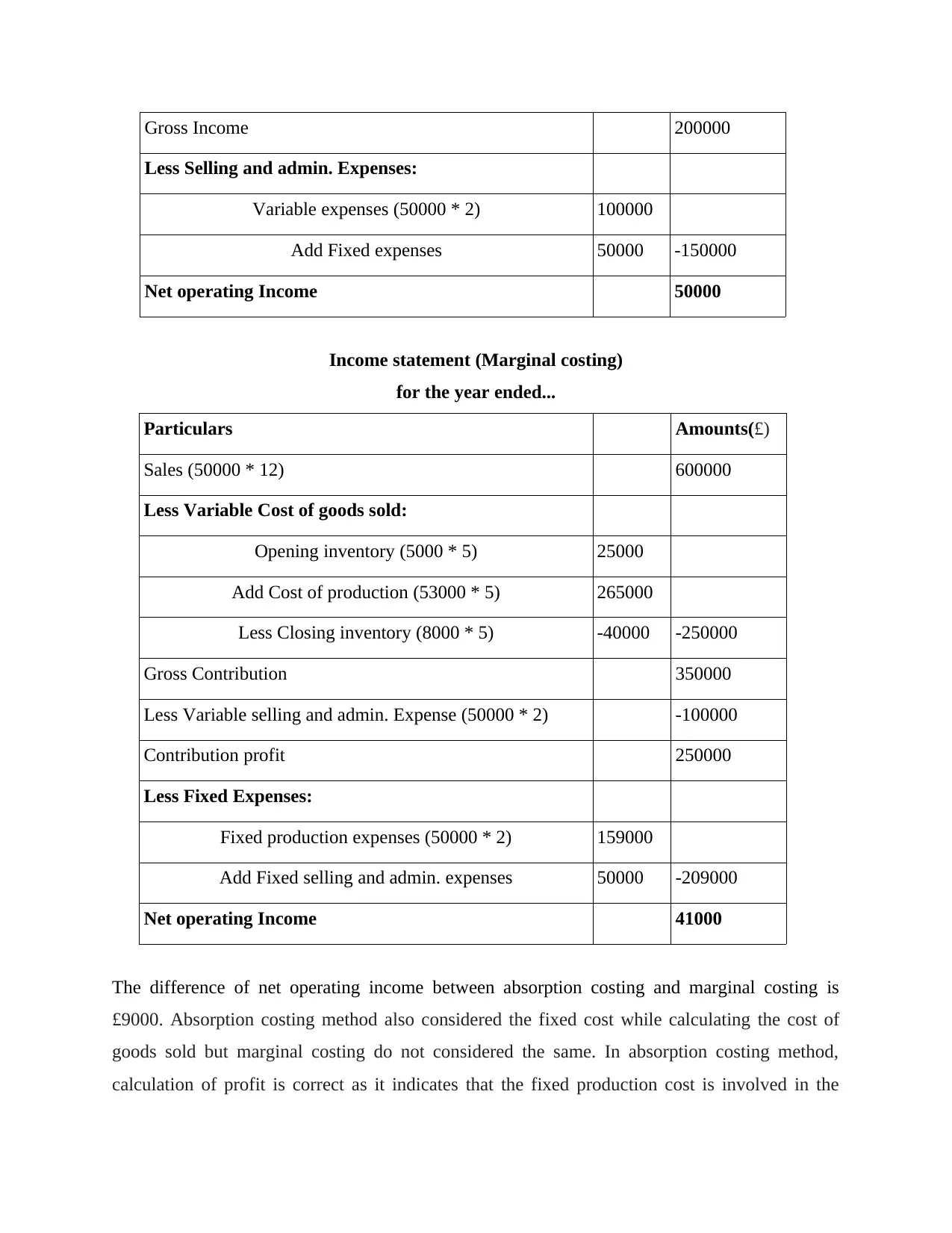
Gross Income 200000
Less Selling and admin. Expenses:
Variable expenses (50000 * 2) 100000
Add Fixed expenses 50000 -150000
Net operating Income 50000
Income statement (Marginal costing)
for the year ended...
Particulars Amounts(£)
Sales (50000 * 12) 600000
Less Variable Cost of goods sold:
Opening inventory (5000 * 5) 25000
Add Cost of production (53000 * 5) 265000
Less Closing inventory (8000 * 5) -40000 -250000
Gross Contribution 350000
Less Variable selling and admin. Expense (50000 * 2) -100000
Contribution profit 250000
Less Fixed Expenses:
Fixed production expenses (50000 * 2) 159000
Add Fixed selling and admin. expenses 50000 -209000
Net operating Income 41000
The difference of net operating income between absorption costing and marginal costing is
£9000. Absorption costing method also considered the fixed cost while calculating the cost of
goods sold but marginal costing do not considered the same. In absorption costing method,
calculation of profit is correct as it indicates that the fixed production cost is involved in the
Less Selling and admin. Expenses:
Variable expenses (50000 * 2) 100000
Add Fixed expenses 50000 -150000
Net operating Income 50000
Income statement (Marginal costing)
for the year ended...
Particulars Amounts(£)
Sales (50000 * 12) 600000
Less Variable Cost of goods sold:
Opening inventory (5000 * 5) 25000
Add Cost of production (53000 * 5) 265000
Less Closing inventory (8000 * 5) -40000 -250000
Gross Contribution 350000
Less Variable selling and admin. Expense (50000 * 2) -100000
Contribution profit 250000
Less Fixed Expenses:
Fixed production expenses (50000 * 2) 159000
Add Fixed selling and admin. expenses 50000 -209000
Net operating Income 41000
The difference of net operating income between absorption costing and marginal costing is
£9000. Absorption costing method also considered the fixed cost while calculating the cost of
goods sold but marginal costing do not considered the same. In absorption costing method,
calculation of profit is correct as it indicates that the fixed production cost is involved in the
⊘ This is a preview!⊘
Do you want full access?
Subscribe today to unlock all pages.

Trusted by 1+ million students worldwide
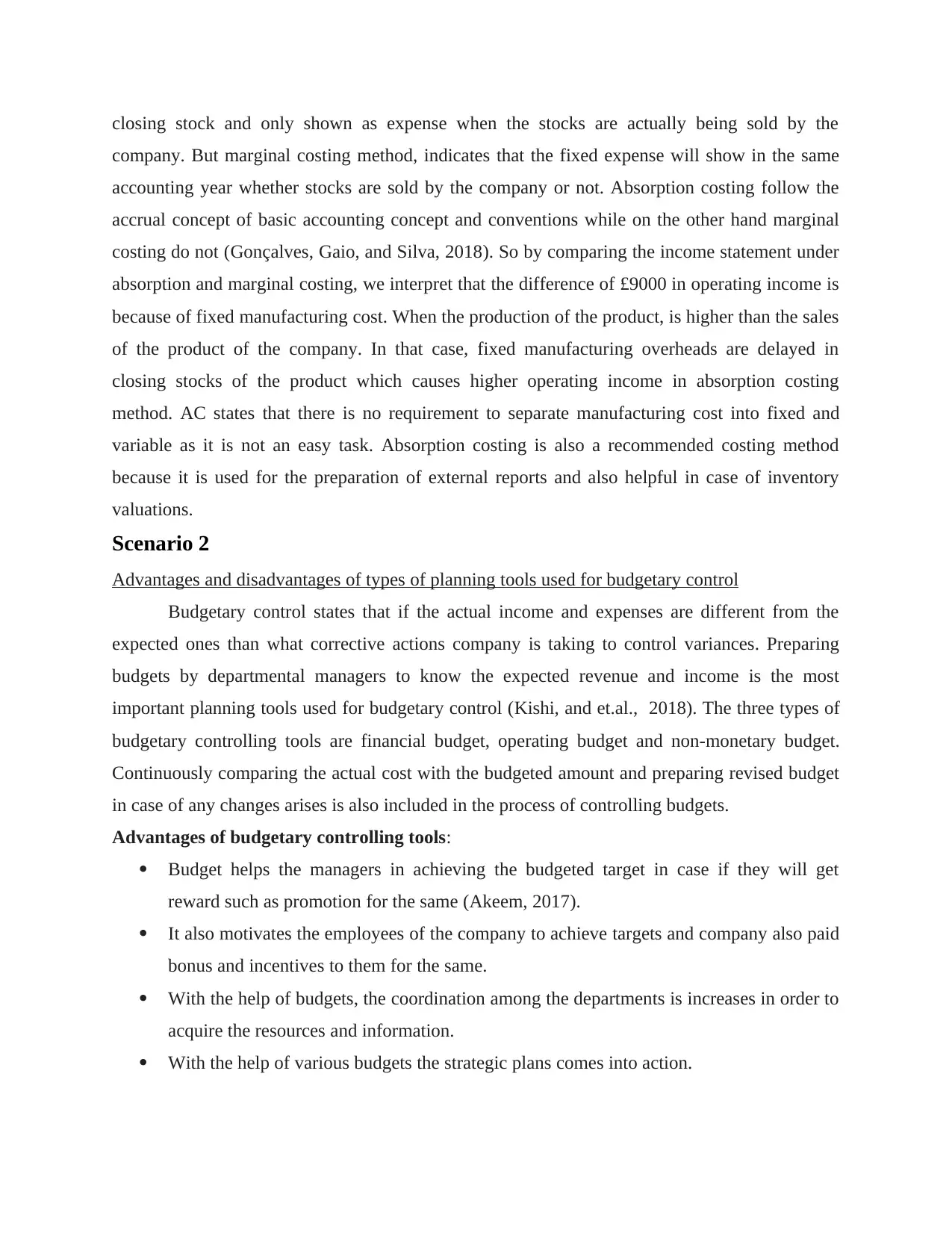
closing stock and only shown as expense when the stocks are actually being sold by the
company. But marginal costing method, indicates that the fixed expense will show in the same
accounting year whether stocks are sold by the company or not. Absorption costing follow the
accrual concept of basic accounting concept and conventions while on the other hand marginal
costing do not (Gonçalves, Gaio, and Silva, 2018). So by comparing the income statement under
absorption and marginal costing, we interpret that the difference of £9000 in operating income is
because of fixed manufacturing cost. When the production of the product, is higher than the sales
of the product of the company. In that case, fixed manufacturing overheads are delayed in
closing stocks of the product which causes higher operating income in absorption costing
method. AC states that there is no requirement to separate manufacturing cost into fixed and
variable as it is not an easy task. Absorption costing is also a recommended costing method
because it is used for the preparation of external reports and also helpful in case of inventory
valuations.
Scenario 2
Advantages and disadvantages of types of planning tools used for budgetary control
Budgetary control states that if the actual income and expenses are different from the
expected ones than what corrective actions company is taking to control variances. Preparing
budgets by departmental managers to know the expected revenue and income is the most
important planning tools used for budgetary control (Kishi, and et.al., 2018). The three types of
budgetary controlling tools are financial budget, operating budget and non-monetary budget.
Continuously comparing the actual cost with the budgeted amount and preparing revised budget
in case of any changes arises is also included in the process of controlling budgets.
Advantages of budgetary controlling tools:
Budget helps the managers in achieving the budgeted target in case if they will get
reward such as promotion for the same (Akeem, 2017).
It also motivates the employees of the company to achieve targets and company also paid
bonus and incentives to them for the same.
With the help of budgets, the coordination among the departments is increases in order to
acquire the resources and information.
With the help of various budgets the strategic plans comes into action.
company. But marginal costing method, indicates that the fixed expense will show in the same
accounting year whether stocks are sold by the company or not. Absorption costing follow the
accrual concept of basic accounting concept and conventions while on the other hand marginal
costing do not (Gonçalves, Gaio, and Silva, 2018). So by comparing the income statement under
absorption and marginal costing, we interpret that the difference of £9000 in operating income is
because of fixed manufacturing cost. When the production of the product, is higher than the sales
of the product of the company. In that case, fixed manufacturing overheads are delayed in
closing stocks of the product which causes higher operating income in absorption costing
method. AC states that there is no requirement to separate manufacturing cost into fixed and
variable as it is not an easy task. Absorption costing is also a recommended costing method
because it is used for the preparation of external reports and also helpful in case of inventory
valuations.
Scenario 2
Advantages and disadvantages of types of planning tools used for budgetary control
Budgetary control states that if the actual income and expenses are different from the
expected ones than what corrective actions company is taking to control variances. Preparing
budgets by departmental managers to know the expected revenue and income is the most
important planning tools used for budgetary control (Kishi, and et.al., 2018). The three types of
budgetary controlling tools are financial budget, operating budget and non-monetary budget.
Continuously comparing the actual cost with the budgeted amount and preparing revised budget
in case of any changes arises is also included in the process of controlling budgets.
Advantages of budgetary controlling tools:
Budget helps the managers in achieving the budgeted target in case if they will get
reward such as promotion for the same (Akeem, 2017).
It also motivates the employees of the company to achieve targets and company also paid
bonus and incentives to them for the same.
With the help of budgets, the coordination among the departments is increases in order to
acquire the resources and information.
With the help of various budgets the strategic plans comes into action.
Paraphrase This Document
Need a fresh take? Get an instant paraphrase of this document with our AI Paraphraser
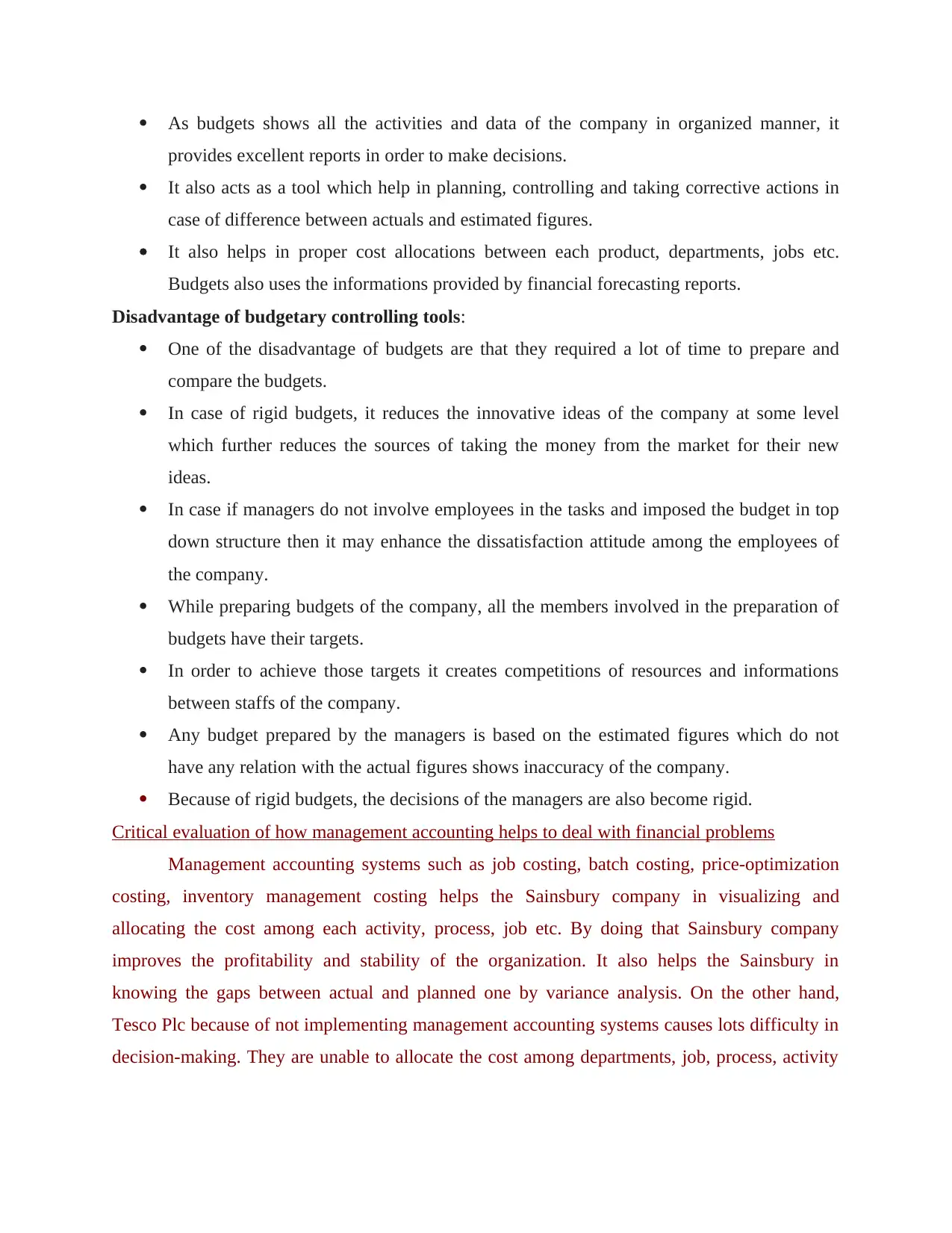
As budgets shows all the activities and data of the company in organized manner, it
provides excellent reports in order to make decisions.
It also acts as a tool which help in planning, controlling and taking corrective actions in
case of difference between actuals and estimated figures.
It also helps in proper cost allocations between each product, departments, jobs etc.
Budgets also uses the informations provided by financial forecasting reports.
Disadvantage of budgetary controlling tools:
One of the disadvantage of budgets are that they required a lot of time to prepare and
compare the budgets.
In case of rigid budgets, it reduces the innovative ideas of the company at some level
which further reduces the sources of taking the money from the market for their new
ideas.
In case if managers do not involve employees in the tasks and imposed the budget in top
down structure then it may enhance the dissatisfaction attitude among the employees of
the company.
While preparing budgets of the company, all the members involved in the preparation of
budgets have their targets.
In order to achieve those targets it creates competitions of resources and informations
between staffs of the company.
Any budget prepared by the managers is based on the estimated figures which do not
have any relation with the actual figures shows inaccuracy of the company.
Because of rigid budgets, the decisions of the managers are also become rigid.
Critical evaluation of how management accounting helps to deal with financial problems
Management accounting systems such as job costing, batch costing, price-optimization
costing, inventory management costing helps the Sainsbury company in visualizing and
allocating the cost among each activity, process, job etc. By doing that Sainsbury company
improves the profitability and stability of the organization. It also helps the Sainsbury in
knowing the gaps between actual and planned one by variance analysis. On the other hand,
Tesco Plc because of not implementing management accounting systems causes lots difficulty in
decision-making. They are unable to allocate the cost among departments, job, process, activity
provides excellent reports in order to make decisions.
It also acts as a tool which help in planning, controlling and taking corrective actions in
case of difference between actuals and estimated figures.
It also helps in proper cost allocations between each product, departments, jobs etc.
Budgets also uses the informations provided by financial forecasting reports.
Disadvantage of budgetary controlling tools:
One of the disadvantage of budgets are that they required a lot of time to prepare and
compare the budgets.
In case of rigid budgets, it reduces the innovative ideas of the company at some level
which further reduces the sources of taking the money from the market for their new
ideas.
In case if managers do not involve employees in the tasks and imposed the budget in top
down structure then it may enhance the dissatisfaction attitude among the employees of
the company.
While preparing budgets of the company, all the members involved in the preparation of
budgets have their targets.
In order to achieve those targets it creates competitions of resources and informations
between staffs of the company.
Any budget prepared by the managers is based on the estimated figures which do not
have any relation with the actual figures shows inaccuracy of the company.
Because of rigid budgets, the decisions of the managers are also become rigid.
Critical evaluation of how management accounting helps to deal with financial problems
Management accounting systems such as job costing, batch costing, price-optimization
costing, inventory management costing helps the Sainsbury company in visualizing and
allocating the cost among each activity, process, job etc. By doing that Sainsbury company
improves the profitability and stability of the organization. It also helps the Sainsbury in
knowing the gaps between actual and planned one by variance analysis. On the other hand,
Tesco Plc because of not implementing management accounting systems causes lots difficulty in
decision-making. They are unable to allocate the cost among departments, job, process, activity
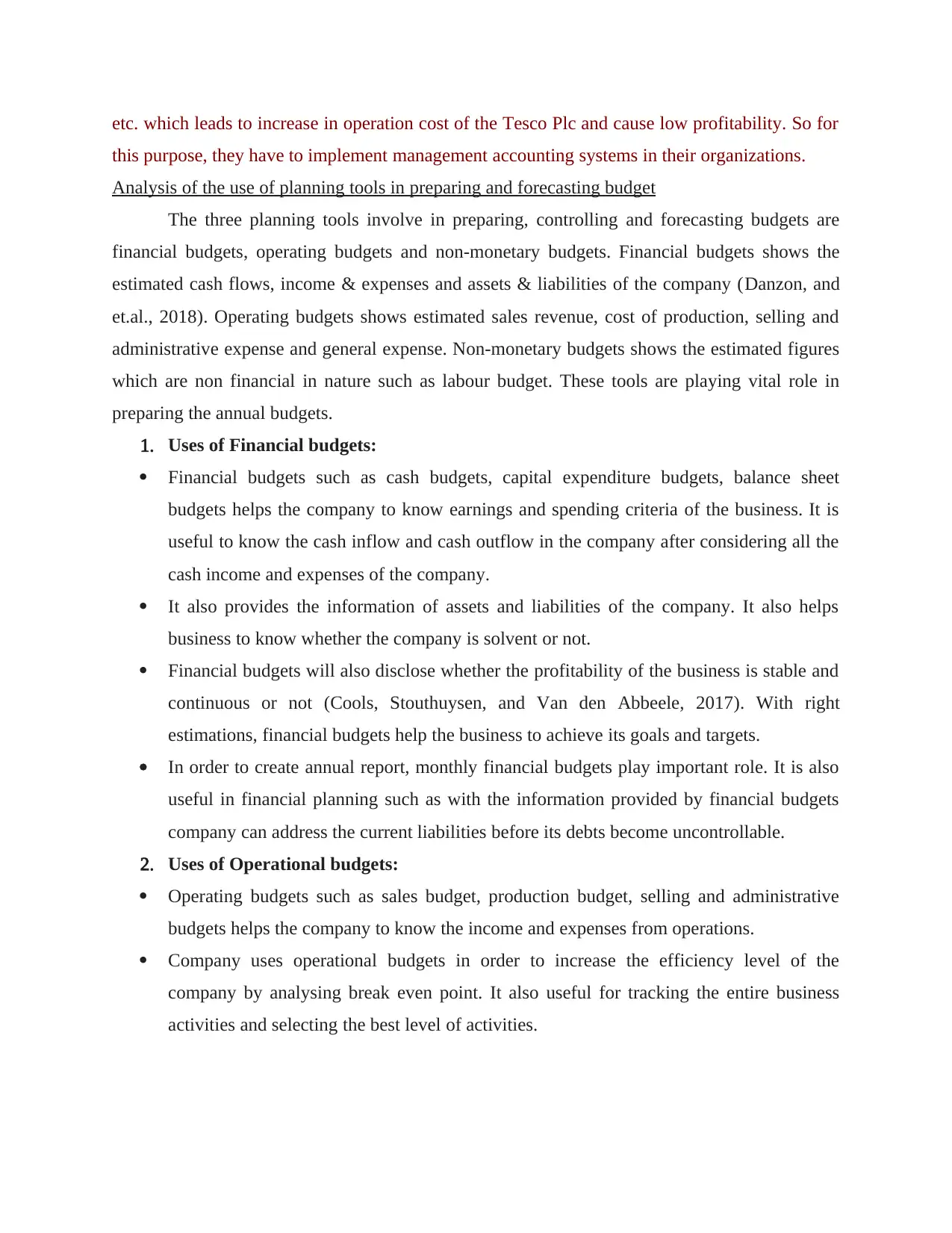
etc. which leads to increase in operation cost of the Tesco Plc and cause low profitability. So for
this purpose, they have to implement management accounting systems in their organizations.
Analysis of the use of planning tools in preparing and forecasting budget
The three planning tools involve in preparing, controlling and forecasting budgets are
financial budgets, operating budgets and non-monetary budgets. Financial budgets shows the
estimated cash flows, income & expenses and assets & liabilities of the company (Danzon, and
et.al., 2018). Operating budgets shows estimated sales revenue, cost of production, selling and
administrative expense and general expense. Non-monetary budgets shows the estimated figures
which are non financial in nature such as labour budget. These tools are playing vital role in
preparing the annual budgets.
1. Uses of Financial budgets:
Financial budgets such as cash budgets, capital expenditure budgets, balance sheet
budgets helps the company to know earnings and spending criteria of the business. It is
useful to know the cash inflow and cash outflow in the company after considering all the
cash income and expenses of the company.
It also provides the information of assets and liabilities of the company. It also helps
business to know whether the company is solvent or not.
Financial budgets will also disclose whether the profitability of the business is stable and
continuous or not (Cools, Stouthuysen, and Van den Abbeele, 2017). With right
estimations, financial budgets help the business to achieve its goals and targets.
In order to create annual report, monthly financial budgets play important role. It is also
useful in financial planning such as with the information provided by financial budgets
company can address the current liabilities before its debts become uncontrollable.
2. Uses of Operational budgets:
Operating budgets such as sales budget, production budget, selling and administrative
budgets helps the company to know the income and expenses from operations.
Company uses operational budgets in order to increase the efficiency level of the
company by analysing break even point. It also useful for tracking the entire business
activities and selecting the best level of activities.
this purpose, they have to implement management accounting systems in their organizations.
Analysis of the use of planning tools in preparing and forecasting budget
The three planning tools involve in preparing, controlling and forecasting budgets are
financial budgets, operating budgets and non-monetary budgets. Financial budgets shows the
estimated cash flows, income & expenses and assets & liabilities of the company (Danzon, and
et.al., 2018). Operating budgets shows estimated sales revenue, cost of production, selling and
administrative expense and general expense. Non-monetary budgets shows the estimated figures
which are non financial in nature such as labour budget. These tools are playing vital role in
preparing the annual budgets.
1. Uses of Financial budgets:
Financial budgets such as cash budgets, capital expenditure budgets, balance sheet
budgets helps the company to know earnings and spending criteria of the business. It is
useful to know the cash inflow and cash outflow in the company after considering all the
cash income and expenses of the company.
It also provides the information of assets and liabilities of the company. It also helps
business to know whether the company is solvent or not.
Financial budgets will also disclose whether the profitability of the business is stable and
continuous or not (Cools, Stouthuysen, and Van den Abbeele, 2017). With right
estimations, financial budgets help the business to achieve its goals and targets.
In order to create annual report, monthly financial budgets play important role. It is also
useful in financial planning such as with the information provided by financial budgets
company can address the current liabilities before its debts become uncontrollable.
2. Uses of Operational budgets:
Operating budgets such as sales budget, production budget, selling and administrative
budgets helps the company to know the income and expenses from operations.
Company uses operational budgets in order to increase the efficiency level of the
company by analysing break even point. It also useful for tracking the entire business
activities and selecting the best level of activities.
⊘ This is a preview!⊘
Do you want full access?
Subscribe today to unlock all pages.

Trusted by 1+ million students worldwide
1 out of 19
Related Documents
Your All-in-One AI-Powered Toolkit for Academic Success.
+13062052269
info@desklib.com
Available 24*7 on WhatsApp / Email
![[object Object]](/_next/static/media/star-bottom.7253800d.svg)
Unlock your academic potential
Copyright © 2020–2025 A2Z Services. All Rights Reserved. Developed and managed by ZUCOL.





